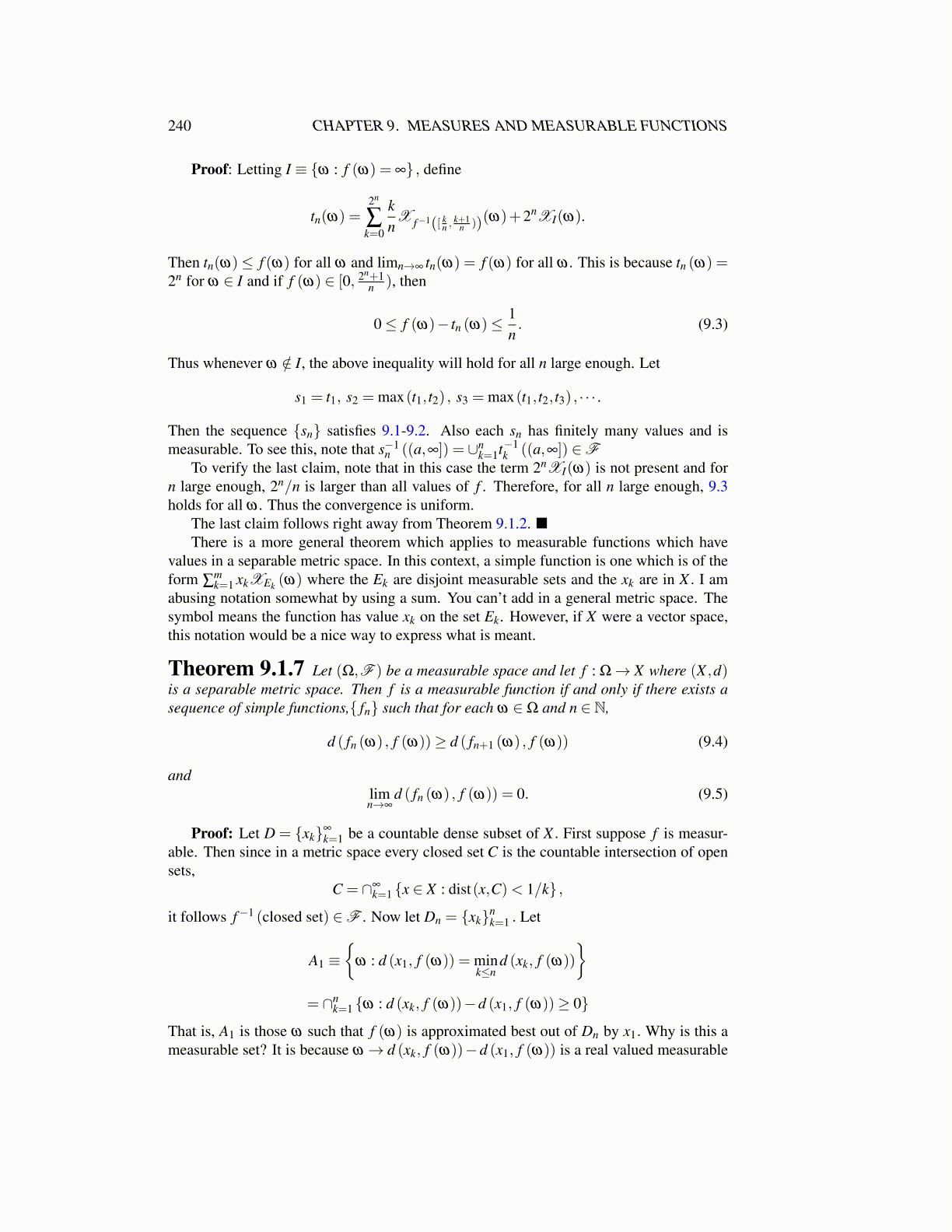
240 CHAPTER 9. MEASURES AND MEASURABLE FUNCTIONS
Proof: Letting I ≡ {ω : f (ω) = ∞} , define
tn(ω) =2n
∑k=0
knX f−1([ k
n ,k+1
n ))(ω)+2nXI(ω).
Then tn(ω)≤ f (ω) for all ω and limn→∞ tn(ω) = f (ω) for all ω . This is because tn (ω) =2n for ω ∈ I and if f (ω) ∈ [0, 2n+1
n ), then
0≤ f (ω)− tn (ω)≤ 1n. (9.3)
Thus whenever ω /∈ I, the above inequality will hold for all n large enough. Let
s1 = t1, s2 = max(t1, t2) , s3 = max(t1, t2, t3) , · · · .
Then the sequence {sn} satisfies 9.1-9.2. Also each sn has finitely many values and ismeasurable. To see this, note that s−1
n ((a,∞]) = ∪nk=1t−1
k ((a,∞]) ∈FTo verify the last claim, note that in this case the term 2nXI(ω) is not present and for
n large enough, 2n/n is larger than all values of f . Therefore, for all n large enough, 9.3holds for all ω . Thus the convergence is uniform.
The last claim follows right away from Theorem 9.1.2. ■There is a more general theorem which applies to measurable functions which have
values in a separable metric space. In this context, a simple function is one which is of theform ∑
mk=1 xkXEk (ω) where the Ek are disjoint measurable sets and the xk are in X . I am
abusing notation somewhat by using a sum. You can’t add in a general metric space. Thesymbol means the function has value xk on the set Ek. However, if X were a vector space,this notation would be a nice way to express what is meant.
Theorem 9.1.7 Let (Ω,F ) be a measurable space and let f : Ω→ X where (X ,d)is a separable metric space. Then f is a measurable function if and only if there exists asequence of simple functions,{ fn} such that for each ω ∈Ω and n ∈ N,
d ( fn (ω) , f (ω))≥ d ( fn+1 (ω) , f (ω)) (9.4)
andlimn→∞
d ( fn (ω) , f (ω)) = 0. (9.5)
Proof: Let D = {xk}∞
k=1 be a countable dense subset of X . First suppose f is measur-able. Then since in a metric space every closed set C is the countable intersection of opensets,
C = ∩∞k=1 {x ∈ X : dist(x,C)< 1/k} ,
it follows f−1 (closed set) ∈F . Now let Dn = {xk}nk=1 . Let
A1 ≡{
ω : d (x1, f (ω)) = mink≤n
d (xk, f (ω))
}= ∩n
k=1 {ω : d (xk, f (ω))−d (x1, f (ω))≥ 0}
That is, A1 is those ω such that f (ω) is approximated best out of Dn by x1. Why is this ameasurable set? It is because ω → d (xk, f (ω))−d (x1, f (ω)) is a real valued measurable